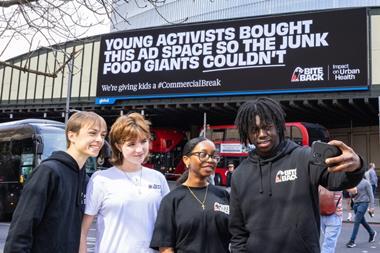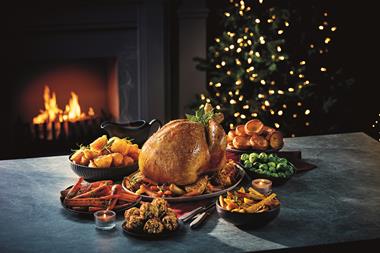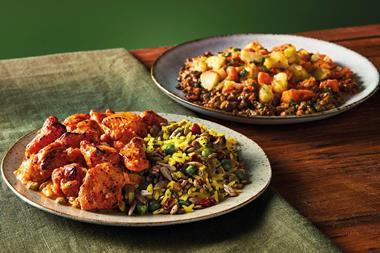In the colossal process of bringing together two giant companies, Unilever Bestfoods UK is determined not to get so bogged down in integration that business continuity goes by the board, as sales director Tony Smith tells Karen Dempsey in an exclusive interview.
In the corridors of consumer companies, there's always plenty of talk of acquiring and absorbing. But the politically correct Unilever way of talking about the integration of the newly acquired Bestfoods business is a "transformational merger".
What this means is that, rather than just pulling together two companies Van den Bergh and Bestfoods into one building and sticking a new logo on the letterhead, the challenge is to ensure the merger transforms both businesses.
But this transformation into a 3,000-strong company with a UK turnover of nearly £900m is bound to inflict a few growing pains. Bringing two portfolios of strong consumer brands under one roof will obviously have brands and egos jostling for space. (The EU has already ruled there is no room for Batchelors and Oxo, which Unilever is in the process of selling to Campbell). And it also begs the question of how the transformational merger will transform Unilever Bestfoods UK's relationships with the retail trade.
The rest of the world won't see the company's new face until April 2. But The Grocer has been given an exclusive peek behind the scenes in an interview with sales director Tony Smith, a key protagonist in the integration process.
The biggest danger they have all faced is getting too bogged down in the integration process as competitors stand on the sidelines, gagging for them to take their eye off the ball.
"The single biggest threat is if we lose sight of the fact we have to deliver growth and deliver synergies," says Smith. "You could very easily become obsessed with the process of integration and the thing you could lose most easily would be business continuity. If your competitors think you're obsessed by integration, then you become a big sitting target, so we're really conscious of the fact we won't stand still in our market.
"We've had to carefully manage business continuity so that when we get to the end of this process, we've got a business which is growing, and that we're not in the situation of trying to recover from something."
Unilever Bestfoods UK has already had a few teething problems on the operational front which have needed urgent tackling. Smith says there has been a supply chain issue "where the level of service has not met the expectations of the Bestfoods business. But we have worked incredibly hard to stabilise that, show good improvement, and bring it to where we want it to be".
Another major challenge, says Smith, is "balancing the quality of what you do and the pace at which you do it. I suspect to some people it might look as through we're not doing it quickly enough. But when you bring two businesses of this size together, you have to do it in a really measured way."
What the integrators have also had to resist is the urge to chuck out all the old corporate chintz the structure that has worked for years and that has created two very successful businesses and replace it with something more arty and experimental.
Smith says: "This is not an organisational design project or an exercise in what you can do with a blank canvas. This is about bringing two enormous companies together."
What has emerged is not a hotch-potch of Bestfoods furniture loosely covered in Van den Bergh upholstery. The aim of Unilever Bestfoods UK is to bring together the best bits of both companies into a streamlined operation which fits more snugly with the retail trade it services.
The engine room of the new structure which will be based at an adapted and enlarged version of Van den Bergh Foods' Crawley site is the 165-strong sales division (under Smith) which is called the customer management organisation'. In fact, Smith goes to great pains to stress that keeping customers happy is the fuel that will power that engine.
While the back room part of the merger won't be so speedy, Unilever Bestfoods UK has gone full steam ahead to ensure it will present a united front to its customers and to the global retail stage come April 2.
What customers will see is a four-pillared structure, the foundations of which were laid at Van den Bergh Foods three and a half years ago. Then, a structure was created with what Smith says was "a good lock-in between customer management and category management".
"But one of the features of the new organisation is the scale of what we are building," he says. "It's not simply a collection of account teams or category teams. And bringing two businesses together gives us the opportunity to do things we've not previously done in either business."
The first pillar consists of five customer teams set up to service the major retailers.
The second is a specialist implementation team that covers merchandising, promotions, and project management which Smith says in the past was one of the weaker areas. The plan for this division is to work with customers to approach product launches differently. "And we'll think about how we can implement innovations with our customers in a different way to get really great results in store," he adds.
The third is four category teams grouped round Beverages, Spreads, Knorr Savoury, and Dressings & Local Jewels (see diagram overleaf). Smith says this is where the integration of the two portfolios is most apparent. "You can really see the impact here of the integrated business and the breadth of the product portfolio within Knorr Savoury and Dressings, where we are locking together the brand portfolios of the two companies."
The fourth, brand new pillar is the customer innovation team which will look at developing strategies for emerging channels and how the company differentiates its customer strategies (not just between customers but within customers that have different formats under the same fascia).
What it will also be taking a fresh look at is the independent sector something Bestfoods was particularly strong in. "What we're going to do is segment it differently and think of it rather than a wholesale business as a route to a retail market.
"Convenience retailing offers a great growth opportunity for the right branded concepts," says Smith. "One of the things Bestfoods has been hugely successful is in developing its impulse business in convenience stores particularly with Pot Noodle and that's something we're going to give tremendous focus on growing further".
Now that the sales model is in place, the organisation is in the process of populating the different divisions. Smith says it is too early to put names to roles. Because of the number of employees involved, they are still going through a legal process of consultation, so public statements won't be made until after March 1. But so far the process doesn't seem to have been littered with casualties. "We haven't started by asking how we can get fewer people working in sales in the organisation," says Smith. "It's not a question of reapplying for your own job in sales. We've got more roles and opportunities here than we've got people to fill them. This wasn't a process of selecting those who could work in the organisation and those who were unlucky not to be offered a role. We're in the reverse. We recognised that people had to have the opportunity to signal their preferences for roles within the organisation and when we populate the customer management organisation we will do it as much as possible in line with people's preferences."
What has been quite a challenge is dealing with "the whole people thing [which] has been quite sensitive", Smith says. "Our chairman [Gavin Neath] has an open and immediate style of communication. He runs what he calls his town meetings' where he invites everybody and he stands and talks about what's happening and where we are. So it's a question of guiding people through and giving them real, honest communication. And also recognising at times that you can get it wrong. And if you get it wrong, you can deal with it."
Something Unilever Bestfoods UK also has to deal with is the question of culture. Integrating two companies means bringing different cultural baggage which has to be unpacked in a coordinated manner. The new company's tactic is to take a "softly, softly, we're all in this together" kind of approach.
"If you think you can instil culture in an organisation you're deluding yourself," says Smith. "As leaders of a business, you set a really clear context of how you want this business to operate and you have to be really clear about what purpose of Unilever Bestfoods is what would be the characteristics of the company, and what would be the values and the behaviours that we stand for. And then within that context, you work with your employees so that everyone has a role in shaping the company and in co-inventing the culture."
Unilever certainly does have big expectations. Its Path to Growth strategy with the focus on power brands has already culled more than 600 brands, with another 300 earmarked for disposal.
And with a 7% increase in turnover over the past year the City is patient with the company's prediction it will achieve 5%-6% top line growth by 2004.
Smith says: "Unilever expects growth and expects growth and expects growth. And on top of the growth it expects us to deliver the synergies Niall FitzGerald told the City that we would deliver. And we will do that."
Smith says the scale of the new organisation means the combined businesses will grow faster than they would have done as separate businesses. "With two brand portfolios, we have a fantastic opportunity to drive growth through product innovation, excellent implementation and brand support."
Smith isn't giving away to competitors what the fantastic product innovations are going to be, and won't hint at what fate has in store for the combined brand portfolio. "We want to work closely with our customers and talk to them a long time before we go public."
What we know from FitzGerald is that there are about 20 innovations due out from Unilever this year. We know organic is on the cards as Unilever Bestfoods has just acquired 90% of the shares in Scottish organic food company Go Organic. The company will not be integrated into the main business but it will provide a platform for potential organic launches.
As far as the main business goes, we know Knorr and Hellmann's from the Bestfoods portfolio are priority brands. One of the new category teams is even structured around Knorr, and this has sparked off the rumour some of the products will be rebranded with Knorr as a prefix. Smith says: "There will be a programme over the next three to four years of some tremendous products emerging from the business. We're doing a huge amount of work developing brand strategies. Unilever paid a great deal of money to acquire some outstanding brands and has spent a great deal of money to build outstanding brands in Van den Bergh." (And with a £100m marketing budget, the company will continue to spend on developing its brands.)
"We're hardly going to give those brands up because they have got strong positions in their markets, and we will do nothing with any of our brands that doesn't have a clear consumer rationale."
Smith will admit he admires the way Unilever's Birds Eye brought its new frozen ready meal range Enjoy! to the market. "In the past brands have been launched well, supported well, and implemented well, but there was always a sense of was it radical enough, was it really great? I was struck by what Birds Eye did with Enjoy! as that was a very different way of approaching a frozen product launch. So we'll have our own Enjoy!s."
{{FEAT. COVER }}
Close menu
- Home
- Retail & Wholesale
-
Products & Suppliers
- Back to parent navigation item
- Products & Suppliers
-
Product Categories:
- Back to parent navigation item
- Product Categories:
- Alcoholic drinks
- Bakery
- Cereals & breakfast
- Cheese
- Chicken & poultry
- Chocolate
- Confectionery
- Crisps, nuts & snacks
- Dairy
- Fish
- Fresh produce
- Frozen
- Household
- Meat
- Own Label
- Sauces & condiments
- Seasonal
- Soft drinks
- Vaping
- Vegan & plant-based
- World foods
- Suppliers
- People
- Reports & Data
-
Topics A-Z
- Back to parent navigation item
- Topics A-Z
-
Popular topics:
- Back to parent navigation item
- Popular topics:
- Cost of living crisis
- Crime
- Deposit Return Schemes
- Finance
- Government & Regulation
- Health
- Inflation
- Loyalty
- Marketing
- Mergers & Acquisitions
- New Product Development
- Sourcing
- Supply chain
- Sustainability & environment
- Technology
- Ultra Processed Foods
- Vaping
- A-Z all topics
- Content by type:
- Events
- Ask iA (beta)
- Subscribe now
Sign in to comment on this article
Not logged in before? Register for FREE guest access today.
You will be able to:
- Read more stories
- Receive daily newsletters
- Comment on stories
Advert



















No comments yet